 May Day, a worldwide celebration of the worker has recently become a holiday for contract workers in Korea. Since native English teachers are employed as contract workers one of the perks is that we get the day off - and so I hopped on a bus and headed out to Saejae for Chasabal, the annual ceramics festival. I attended the festival last year which you can read about here. I thought it'd be a quiet day at the festival wondering around and snapping photos. However, the day didn't quite go as planned since while I was waiting for the bus I met Kylie, a Chinese woman on holiday from her job in Australia. She had been visiting a friend in Daejeon and on a whim she decided to travel to Mungyeong for the festival. Unsure what bus to take she asked me about it at the stop and we struck up a conversation and ended up spending the day together. In an effort to repay some of the kindness shown to me on my many travels I even invited her to spend the night at my apartment so she could avoid paying the hefty 70,000 won at the tourist hotel near Saejae (which still was kind enough to hold her luggage for her). After disembarking from the bus we made our way to the festival which was held in a replica of a traditional village which is used for television dramas. My goal for the day was to purchase a few ceramics from the local artisans - all master potters who work in the Mungyeong tradition. I had a miscommunication with one of my students and mistakenly believed his father would be featured there so we set off to find him. After a bit I realized he wasn't there so we visited a variety of shops as I tried to get a feel for different potters and their style of work. While overall I would say the pottery was reasonably priced - teabowls were about 20,000 won (~$20 USD) there were some pieces that required greater skill such as teapots which easily fetched $100 or more. My first purchase was a simple oblong vase that I fell in love with because it had a small carp sculpted on the bottom. It was there that I received "service" a common Korean business technique which means a freebie. The potter gave me a small teacup. After walking around a bit we stopped at one of the buildings for a cup of tea. This is a regular event at the replica village - not something unique to the festival. However, during my previous visits only a single type of tea was available but we discovered that for the festival there were 4 different types of tea. Kylie and I tried each type of tea and watched curiously as the women prepared each type differently and served the tea in equally diverse tea cups. During each visit the women making the tea would try to chat with Kylie in Korean and none seemed to realize that it was me, the white girl, that typically understood what they were saying rather than Kylie who is Chinese. After our enjoying the tea we wandered over to the part of the village which boasted the international master potters. We met artisans from all of the world and they advised us that one of the potters was getting married in the village at that very moment. Kylie and I quickly headed over to the ceremony which was held outdoors for all the visitors. The ceremony was an abbreviated form of the traditional Korean ceremony. The groom, a Korean potter and his Japanese wife were married during the ceremony with dozens of friends, strangers and their two young boys looking on. As the ceremony came to a conclusion we began to walk back through the village and stopped briefly for a quick photo while wearing royal traditional clothing. Then we walked around a bit more and I picked up 2 tea cups (with a third one thrown in as service) and a small flower vase. Afterwards we walked over to the food area and ate some incredibly over priced and not very good food. Once we were done at the festival we began the journey back to Jeomchon - walking to the bus stop and waiting for the bus which turned out not to be schedule to arrive for a couple of hours, taking a taxi back to Mungyeong and a bus from there to Jeomchon and then walking to my apartment. Afterwards we met up with my friend Grant and we went out for a traditional Korean meal since Kylie hadn't had one yet. A traditional meal usually includes a bit of fish, rice and a lot of side dishes, called banchan. Following dinner we headed back to the apartment and crashed after the long day. The following morning Kylie went to Andong to visit Hahoe Village on my recommendation and I headed off to school.
0 Comments
After my previous long-winded tale of disappointment and frustration about an issue with my school I thought the follow-up entry should be something positive like the Amazing Taste! ~ the cooking class I led with my night class students at the end of April. Overall the class was a major success though there were a few hiccups. For some background information on my after school class read more about it here in the entry "Mindy's Global Class." After weeks of learning about other countries I decided to let the boys learn how to make a few different recipes from around the world. A couple of students asked to learn how to make curry but I decided it was too time intensive for a class such as this (I hope to lead a cooking class on curry before I leave though). I found a few recipes from countries which we had studied or would study. I decided on Vietnamese spring rolls, peanut butter blossom cookies, guacamole and chips, soda bread and tortilla Española. One student specifically requested to make soda bread so I added that to the list - it seems he really enjoyed eating it during our lesson on St. Patrick's Day. I chose the tortilla for the lesson because it went over so well in my night class the previous semester and we had also studied Spain during our class on Europe. Faced with the prospect of having 14 students working with knives, hot oil and other potentially dangerous times I asked my friend Grant to assist me with the class (I actually paid him my hourly fee). I felt more comfortable knowing that there would be another adult there to help supervise and having him in class gave the boys the opportunity to speak English with someone other than myself. I suspect they really enjoyed chatting with him since many had never met a male (or even non-white) foreigner before. The day before the class I prepared all the materials at my home - cutting up and/or measuring out all the ingredients and putting them into marked plastic containers. I also gathered all the cooking utensils and other items necessary for the class. At school the next day I created a little packet for each boy with the recipes we would be using and a little back ground information about the dish. At the start of class I stressed the importance of good hygiene - I've noticed that levels of hygiene aren't quite up to what the U.S. holds as a high standard. This is especially true regarding washing ones hands after using the bathroom or sneezing/coughing into one's arm (or even hands!). After marching the boys into the teachers room and making them wash their hands we started our lesson. The students divided into smaller groups and went to their designated areas. Each group came up to me and got their ingredients and then began the process. Grant and I (and eventually my co-worker Ms. Yu) intermingled with the boys, helping groups as they needed it. Sadly, we immediately realized my first mistake - I forgot the rice papers for the group making Vietnamese spring rolls. Instead they had to make lettuce wraps which aren't quite as tasty. While I walked around helping the different groups we quickly discovered my second big mistake. When I halved the cookie recipe for one of the groups I neglected to cut in half the amount of banana used (I don't eat eggs and banana is a good substitute for eggs). The dough was much too wet and I had only brought a limited amount of flour. Jae Myeong, the student pictured above on the right kept yelling "it's your fault!" at me as he tried to form into balls the much too soft dough. Though there were a couple of issues overall the cooking lesson went quite well. It easily ran over the 2 hour class and so the boys got to miss the supervised self-study class they had following it (something which I think they didn't mind at all). After all the food was prepared we cleaned up and then everyone sat down to eat. I asked them in a following class what they thought of the food and surprisingly most said their favorite item was the soda bread. The least favorite dish was the guacamole - I suspect because of its completely foreign flavors and texture. I'm going to provide a spoiler for this story by saying that it has a happy ending - well, in a way. I wanted to preface the story with a reference that it has a somewhat positive ending because as you might guess by the title this isn't a happy post. This entry highlights one of the reasons why I lost a lot of respect for the school administration for which I work and just added the fuel to the fire of why I am eagerly counting down the days until I leave Korea.
This story is about my after school classes which I've talked a lot about my on this blog. They will be some of the best memories from my time in Korea and I've really enjoyed the opportunity to get to know some of my students better. Of course, I do not do these classes for free - they're extremely time intensive and I try to incorporate a few hands on activities which require purchasing some materials. The story itself is a bit long because it involves explaining some of the intricacies of working in a Korean school. Last fall I was approached by my handler (a fellow English teacher who is paid a set amount monthly by the board of ed for "helping" me). He asked me if I was interested in teaching 40 hours of after school classes and I jumped at the chance. I was told that I would be paid 30,000 won an hour per class. This is more than the 25,000 won minimum specified in my contract and I stated as such - telling him that it was too much. He brushed off my protests and told me that was what Korean teachers are paid. This was confirmed by my predecessor - he also had been paid the same amount as the Korean teachers and therefore I took my co-teacher at his word and believed that I would be paid 30,000 won per hour. Since I knew I would be purchasing a lot of materials out of pocket I asked my co-teacher if the school had a budget for the after school class. A few hours later he came to me and told me that after discussing it with the vice-principal the school would pay for 100,000 won worth of materials as long as I supplied receipts. I agreed and immediately started planning my lessons taking into account the 100,000 as well as the extra money I would be receiving hourly (nearly 200,000 won). I think the lessons I planned went over well - the boys got to carve jack o' lanterns (a first for them) and had the opportunity to try food from all over the world including a proper Indian meal for the Indian holiday of Diwali. The students created posters for speeches and we even had a cooking lesson during one of our classes. Our final lesson was a Christmas party complete with food (some of which was prepared by the boys at the party), sweets and an ice cream cake. Since I have 16 students in my class and I had to find and buy a lot of common and unusual ingredients (orange pumpkins, international food, markers, etc) it probably won't surprise any one that I easily spent 300,000 on everything and I was happy to do so because the students really enjoyed the classes. Unfortunately by the end of the semester I hadn't been able to fulfill the full 40 hours of classes - I only taught 32. Part of this was because I didn't start teaching at the school until a month into the semester due to my previous contract and also because of miscommunications. I didn't realize that I could add additional days to our class schedule or extend class periods in order to meet the 40 hours. Korean co-workers aren't known for being forthcoming about all the details necessary for the native English teacher to competently do one's job - and I neglected to ask the correct questions. In mid- December I turned in my receipts to be reimbursed for the materials I purchased and a few weeks later I turned in my attendance sheet. My co-workers asked me to fabricate some of the dates to fill out the hours so it would show a full 40 hours because it would be "too difficult" and "too much paperwork" to pay me for fewer hours. I flat out refused - the school receives money from the public and I didn't want to be part of taking money which should help educate students. At this point I went on my month long trip and didn't return to school until February. When I returned I was asked again adjust my attendance sheet - I was assured I would not be paid extra but it was necessary for paperwork. I finally agreed and found myself having to change it multiple times to suit the needs of whomever is in charge of paying out the teachers (by the end of the saga though I have never met the man I strongly dislike him - it sounds like he fudges a lot of paperwork because "it's too difficult" to do do it correctly). I began to check my bank account to see when I was paid and finally noted that I had been paid for my teaching hours but not reimbursed for the materials. I approached my handler about this issue and he made a few calls and claimed that the amount I had been paid actually included the reimbursed money. From here there was a lot of discussion and a lot of frustration. I'll save you the blow by blow but the end decision was that I had been paid too much - I would only receive 25,000 won an hour (per my contract) and so the amount I had been paid included my hourly wage and the reimbursed money as well as a bit extra. My school would kindly ignore the extra and not require me to pay them back. It was explained to me that it was "not possible" to pay the possible 30,000 won because my contract only allowed for the 25,000 hourly pay. This simply isn't true, as I explained before my predecessor was paid the same hourly wage as the Korean teachers for 2 years though his contract also stated a smaller amount. I was somewhat incredulous at this stance since I had been very honest and upfront about my hourly wage and told him that the school should stand by its word and I wouldn't believe anything they said in the future. I guess the discussion regarding my payment was on-going - I'm sure everyone in the school knew about this somewhat private concern because there is a lack of privacy in Korean schools and my co-workers enjoy gossiping. They speak openly about me in the office in Korean while I sit at my desk (it's one of the reasons I am thankful I don't speak much Korean, I suspect I'd truly dislike some of my co-workers if I knew what they were saying). In the end they told me they stood by their original assessment - I had been over-paid. The entire experience really soured me on the school - I went out of my way to create a integrative educational experience with a lot of original material while the Korean teachers just read from a book during their classes and not only did I feel it was not acknowledged by the school I felt disrespected. I didn't let this sway me from teaching after school classes again for the second semester - I just reminded myself I was doing it for the students and planned out plenty of hands on activities for them dipping in my own pocket for the supplies. So far we've dyed Easter eggs, enjoyed food from around the world, had a night dedicated to cooking and we're currently making pinatas. My reward was when after sports day every single one of my students came to my night class and they told me how their friends said they pitied them for having to attend the class but they didn't mind because they loved my class. It really warmed my heart to hear that and reminded me why I shouldn't regret staying a second year. But this isn't the "happy ending". For a few weeks the issue was completely disregarded until one day at lunch one of my co-workers handed me an envelope. She explained that the English teachers felt bad that the school refused to pay me the proper amount and it was known that I had spent a lot of extra time and money on the students. The teachers conferred and decided get together and give me the 100,000 won difference, each one giving a set amount. I was extremely touched by this action and so I baked cookies and distributed them to the 5 English teachers to thank them for trying to right the wrong that the school had done. I'm still disappointed with my school and the fact that the administration didn't keep it's word. However, I continue to remind myself that I what is important is that I have a good relationship with my students - I enjoy teaching them and they enjoy my classes. I leave in just 3 months and then I can put this issue and many others that I've encountered here in Korea behind me. While I'll be sad to leave my students in August I am very much looking forward to leaving Korea. It is definitely time for me to go home. 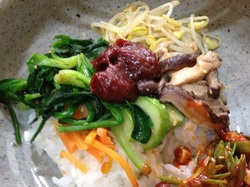 In March I realized that I would be leaving Korea in less than 6 months and so I decided to take advantage of an opportunity that recently had presented itself. I learned via the waygook-in grapevine of a bi-monthly cooking class that was being held in Daegu for foreigners. I immediately got in touch with a woman who was helping to organize the class to ensure that it would be appropriate for vegetarians and she confirmed it could and so I committed to a class. The class is held in the far side of Daegu - a city which is approximately 1 hour and 30 minutes from Jeomchon. From there I had to take a taxi to the closest subway line and then take the subway to one of the last stops on the line. In all it takes approximately 2 1/2 hours from Jeomchon and costs nearly 40,000 won ($35 USD) just for travel. Each class costs 30,000 won. The cooking classes are organized by a woman and her friends - all current or former Korean English teachers. The leader is a woman who lived in the U.S. for 7 and has only become interested in traditional Korean cooking in the past decade or so. She holds the classes in a small store front where she sells pottery which she also makes. Our first lesson was on the popular dish bibimbap. The dish is incredibly simple - rice topped with vegetables, meat (if you so choose), egg and the ubiquitous gochujang, a sweet and slightly spicy sauce that is common in Korean food. Though bibimbap is an incredibly easy food to make it is a bit time consuming since each vegetable is cooked and seasoned separately. The cooking class is conducted in the back room of a small store - the small alley kitchen in the store is not large enough to accommodate the 4 class participants. Therefore a small portable gas burner is used to prepare the food. Due to this set-up the class is not very hands on. The cook instructs how to make the food while the participants observe her. Occasionally we're invited to stir an item or mix in an ingredient. In addition to the main dish the women typically prepare a small amount of banchan - side dishes that are traditionally served with Korean food. Kimchi is probably the most common banchan but vegetables and sometimes fish or meat are also popular side dishes. For lunch kimchi, which had been prepared in advance, in addition to tofu and fried zucchini was served. After eating lunch we enjoyed some tea along with simple fried dough topped with real azalea flowers. While we ate we chatted about a variety of things - the Korean English teachers all speak excellent English and were very curious about different aspects of Western culture. After our first class we were given a small hand made ceramic cup as a gift for attending. In our second cooking class we learned how to make japchae - a dish of stir fried vegetables and meat with sweet potato cellophane noodles. I actually really enjoy this dish so I was excited to learn how to make it. The preparation for japchae is similar to bibimbap in that all the vegetables are cooked and seasoned separately until they're put together for the final dish. We enjoyed this dish alongside a small bowl of rice and a variety of banchan including cabbage kimchi (the most common type of kimchi) and cucumber kimchi. I enjoyed the cucumber kimchi so much that I have since found a couple recipes and I hope to make it sometime in the near future.
While I enjoy the cooking classes and the company of both foreigners and Koreans I am not sure if I'll continue them in the future. The cost is a bit high due to the long distance I have to travel to Daegu. Also, with my time in Korea quickly diminishing there are a few things which I'd like to do on the weekends and so my schedule is not as open. 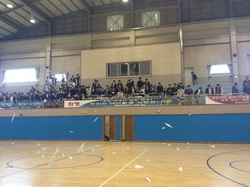 Last month we had a day off of classes for the annual science day. I'm not really clear about the purpose of science day. I assumed it would be a day where students would show off science projects or partake in fun experiments. Perhaps that was going on while I was busy elsewhere ... Though the day was officially called science day some students were required to sign up for an English activity - a listening test or interview. I was asked to create the interview questions based on the topic of family and then interview approximately 20 students. As usual I was kept in the dark about most of what was going on and my students were the ones to shed some light - they explained that it was a competition of sorts and the students who received the top scores would receive a small gift certificate to the school store. It was enjoyable to sit down and have an albeit brief opportunity to chat with a few students one on one and learn more about their lives. A few students were stand outs among their peers in regards to their spoken English levels and I was happy to hear they were awarded the prize.
The second portion of Science Day was a school wide airplane competition. Earlier in the day students made paper airplanes and after lunch they flew them in the gym. Out of the airplanes that landed in a specific area the teachers went out and each picked one. The students whose airplanes were picked received a gift certificate. With the conclusion of science day school was dismissed early and I was able to 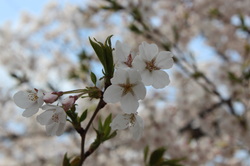 Spring has been weird here - it'd get quite warm for a day or two and then the temperature would drop drastically. However, the odd weather turned out to be a blessing since it seemed to prolong the cherry blossom (벚꽃) season which is woefully short. Cherry blossoms are a welcome sign of spring - the fragile pinkish white blossoms bloom as the weather begins to warm up and flutter to the ground a mere two weeks later. The tradition of the cherry blossom festival was first introduced by the Japanese when they colonized Korea. While some varieties of the cherry blossom trees are native to South Korea others were brought over by the Japanese. For the most part the tradition has continued into the modern age though I did just recently read that some trees have been cut down in recent years because they were perceived as a symbol of the occupation. Like many towns Jeomchon has a cluster of cherry blossom which line the small river which runs through town. When the flowers being to bloom lights are set up to shine on the flowers at night and friends, families and lovers wonder along the river enjoying the blossoms. One lovely afternoon school was released early and I was able to wander along the river and enjoy the cherry blossoms and snap a few photos.
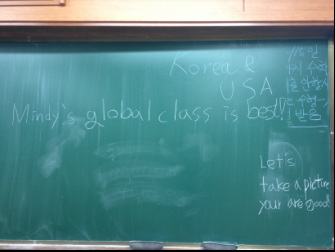 With the start of the new school year I began a new series of night classes for 15 high level 1st year high school students and 1 middle school student (his mother is my co-worker so she requested if he could join). We have classes twice a week for two hour intervals. During our first class I asked the boys to write a few different topics which they would like to study and most of them wrote other cultures. Luckily for all of us studying other cultures is a passion of mine (I do have a degree in cultural anthropology after all) and so I sat down to plan out the next 12 classes about world cultures. The first few classes were basic get to know you classes - we did introductions, talked about music and since one class coincided with St. Paddy's day we studied a bit about Ireland and the holiday. After those first few classes I felt like I knew them a bit so I could plan other class activities appropriately. I spent free time during the next week and almost an entire weekend planning out a 50 page workbook including a variety of activities on other countries and cultures. We focused on 3 countries per continent so the boys would understand how diverse the world is - even on the same landmass. I also made sure that one country featured from each continent was English speaking in order to show the students that English is truly a global language. For each country we had a corresponding activity - the first country we studied had a comprehension portion, for the second country the boys got to try a traditional food and for the third country of the night there was a hands on activity. Though there were plenty of bumps along the way overall I think "Mindy's Global Class" (so named by my students) turned out quite well and the boys enjoyed it. Below is an overview of our classes. After spending a class discussing travel, travel desires and what one needs to travel we started our series of classes on the different continents. Our first class was on Europe since the date corresponded with Easter. I wanted the boys to have the opportunity to dye Easter eggs but wasn't sure how to fit that into a lesson on Europe. After some research I discovered that the American tradition of dying Easter eggs was started by German immigrants who brought the practice over with them in the 1800's. With this information I decided we would study Germany as one of the countries for that class. We also learned about how Easter is celebrated in Malta and enjoyed pimientos asados, a popular Spanish tapa. I took the above photo at the end of class - it seems to be Korean tradition for people not to smile in photographs which is why so many look sullen. Our next class was on Oceania where the students learned about Sing Sing (dance festivals) in Papua New Guinea, got to try some fresh tropical fruit and ended the class with designing their own ta moko (Maori tattoos). While the mango went over incredibly well the boys didn't care for the fresh coconut at all - they described it as tasting like plastic (and I agree, it wasn't a particularly good coconut). Asia was our third destination and so I coordinated a skype chat with the former Native English teacher of Hamchang who moved to Japan last August (pictured below). After the students grilled him on Japanese girls and food and being completely shocked that the average Japanese person does not care about Dokdo/Takeshima ( an island to which both countries lay claim) we transitioned into learning about India. The students had their first taste of Indian food (chana masala and rothi) before class was dismissed. Sadly we didn't have enough time to talk about Vietnam, our final Asian destination. Stop number four on our world tour was South America. We learned about the bio-diversity of Guyana, food in Brazil (accompanied by an avocado milkshake) and the history of Peru with a treasure hunt/quiz. This was the first class when I actually witnessed my rambunctious students being deadly quiet - it seems that concentration type activities like crossword puzzles and maps keep the students entertained.
We moved onto Africa in our next class. My friend Kwame recorded a video about his country Ghana last semester for my class so I played it for the students. It seemed to be a hit - one boy sang along to his song and a few practiced how to say "hello" and "goodbye" in Kwame's native tongue. Afterwards we enjoyed some chakalaka, a popular dish from South Africa and we ended class with the boys writing their names out in Egyptian hieroglyphs. Our last class before a 2 week moratorium on after school class due to mid term tests was a cooking class which I'll write about on a different day. 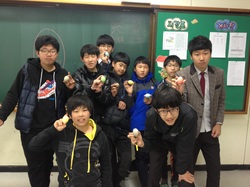 With a new school year comes a hundred or so new students. Hamchang is a village of sorts with a dwindling population. For the most part students attend a local middle school and test into a high school. Approximately 2/3 of the middle school students are local boys that live in Hamchang or the surrounding area and travel to/from school every day.
However, a few years ago the middle school enrollment was shrinking due to the declining population of Hamchang. The school officials decided to coordinate with the local semi-professional soccer team and begin recruiting young soccer players. They hired a couple of coaches and now one of the two classes in each grade is composed of soccer players. These boys come as far away as Busan and Masan (in the southern part of the peninsula) and spend part of the day studying and the rest of the day training. These young boys (some as young as 13 years old) live in dormitories and only return home to see their families once a month for 3 days. Since the middle school graduates only 30-40 students a year and the average high school grade has 120 students boys come from throughout the Sangju and Mungyeong area. Many but not all of the boys live on campus in basic dormitories and are only permitted to go home once every 2 weeks for 2 days. Their day typically starts well before the 9am official start of school. All of the high school students take a class beginning at 8am and after the final bell at 4:50 many continue to take extra classes. For those that live in the dormitory they have scheduled night classes and self-study until 11 at night. It's completely disheartening to know that for many of the boys their lives consist of school, studying, eating and sleeping with limited time for anything else. One of the highlights of my job is that I teach after school classes twice a week. I posted a few photos and even a video of my high school night class last semester. It was a great experience because it gave me the opportunity to get to know some of my students better. Sadly those boys are now 2nd years which means they have to study even harder as they progress closer to their intense final year of SAT preparation (a test which can make or break a student's future). However, with the onset of a new school year I met over 100 new students 20 of whom elected to take my after school classes. Twice a week I teach 40 minute classes with 4-8 middle schoolers during their optional 8th period (pictured above after we dyed Easter eggs). An hour later I lead 2 hour classes with 15 high school boys - our classes typically focus on cultures around the world so they've affectionately dubbed it "Mindy's Global English Class." We've done a lot in those classes together so I'll post more about it as well as photos from the activities in my next entry.  The Korean school year (in my opinion) is organized a bit illogical. The school year has two month long breaks with the second break falling in January and school ending in February. This means that students take their final exams in December, officially have no school in January and then had two weeks of classes in February before they get another break and then a new school year begins. In reality though my students pretty much go to school year round - the month long January break is in reality whittled down to a mere week and students attend special classes for the rest of the month. If the students try to opt out of the classes and try to actually enjoy some free time the teachers call and pressure the parents to send the students to school. It's really quite disheartening for both students and teachers alike since none of them really get any personal time. With the conclusion of one school year and the onset of another teachers come and go and so the school organized an overnight trip from Friday to Saturday for all of the 2013/2014 teachers. This trip was to a town less than an hour's drive away at a small hotel. Once at the hotel we had to sit through a series of meetings on a variety of topics which started at 2pm broke for dinner and then continued until nearly 10pm. I guess no one truly realized it would be a waste of time for me to sit through nearly 8 hours of meetings completely in Korean. While I appreciate that my school tries to involve me in a variety of activities some such as meetings I believe my time could have been better spent working on lessons or proposing ideas for how the English curriculum could be improved at the school. While I found the meetings mind-numbingly boring due to my inability to understand the majority of what was being said I discovered that my co-workers were equally bored and some literally snored their way through some of the presentations. The teachers in front of me crafted an unhappy orange from the hundred or so mandarin oranges which the school brought in. After the meetings the teachers then went out to drink, an activity of which I declined - I am a rather private person and relish my personal space and after spending over 12 hours straight with my co-workers with barely a minute to myself I needed time alone. And so I retreated to my room dreading the constant interaction and meetings which would follow the next day. On Saturday we were only subjected to a couple of hours of meetings before leaving the hotel and heading to Mungyeong Saejae which was nearby. As I've mentioned in previous entries Saejae is a large local park with hiking trails. People go there to 'hike' up to the third gate - an old structure where Korean men once went hundreds of years ago to hear if they passed the civil servants exam. If you have visited Saejae you'll understand why I put 'hike' in parentheses - hiking, for the most part, in Korea involves walking up a relatively developed slightly inclined path. We actually took a bus up to the third gate, hiked up a bit up a mountain to the path and then proceeded down it to the first gate which was approximately 7km away and took several hours. The walk down was quite nice - though it was still winter and there was snow on the ground the sun was shining bright and the air felt crisp and clean. It was a beautiful day for a walk, something I would've enjoyed doing quietly alone but the school's vice-principal insisted that one of my co-teachers walked with me the entire way. Once we completed the path we headed back to Jeomchon but some of the teachers wanted to continue the party and go out for noreabang (karaoke). Korean culture puts a huge emphasis on group activities and it seems, at least to me, that work or work related activities take a precedence over one's private life. I suspect many of my co-workers wanted to go home to their families but a few agreed to continue the party. I on the other hand played the ever useful waygook-in (foreigner) card and feigned ignorance at understanding the importance of such a social event and bid my farewell from the group desperate for some time to recharge my batteries.
The trip itself was quite interesting because it gave me the opportunity to observe how one's career frequently overshadows one's personal time - especially if the person ranks lower in status within the office structure (i.e. young and/or female). It also brought to light how much I don't belong in a collectivist culture - I struggle with the emphasis on togetherness over my need for personal space. I also had many issues with the food situation - although I asked ahead of time if there would be food for me,however since most people at my school let alone Koreans in general don't understand vegetarianism the only food that was actually vegetarian for all 4 meals was rice and a small serving of vegetables. For all of these reasons I recently opted out on another overnight trip for teachers and I am much happier for it. If you've been checking in on my blog periodically you might be under the impression that I have been traveling continuously or just recently ended my trip. In actuality I returned to Korea in February and haven't had the time to keep my blog updated. Quite a bit has happened during the past three months including the end of a school year which was marked by graduation. 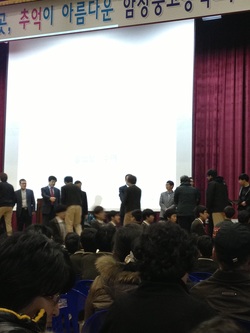 The school year in Korea runs from March to February with 2 month long breaks in between (August and January). As in the U.S. the school year here concludes with a graduation ceremony for seniors. For me the graduation ceremony at Hamchang Boys Middle and High School was a somewhat surprising event. Korea puts a large emphasis on education both in terms of money spent and time devoted by students therefore I thought that graduating from high school would be viewed as a significant achievement with a grandiose celebration - or at the very least acknowledgement of each individual student.
The ceremony was held on a chilly Thursday morning in February. When I asked my co-worker why it was held on a workday instead of the weekend when more parents could attend she said it was because Korean families like to spend the weekends together. I find that reasoning a bit difficult to comprehend since many Hamchang students take extra classes or study at school or tutoring programs until 9-11pm at night. They return home only to sleep and then are back at school early the next morning. Those that live at school are only permitted to go home once every two weeks because parents demand that the school has Saturday classes. Therefore it's a bit hard to believe that the ceremony isn't held on the weekend because it impedes on potential family time. On the day of graduation HBMHS's rather small gym filled up with students, teachers and a couple dozen family members and friends of the graduates. Due to the timing it was not surprising to see that most of the attendees were students' mothers (most are housewives), many of whom had small bouquets of flowers to give their sons after the conclusion of the ceremony. The actual ceremony itself seemed more akin to an advertisement for the school - the promotional video for Hamchang Boys Middle and High School was played multiple times before a variety of school officials and teachers gave speeches. The only real recognition of the students' achievement was when each class was called forth to receive their diplomas. Instead of individual students being brought forth by name the students simply shuffled through the line in single file to receive their certificate. In a matter of an hour or so the entire event was over and the boys left their life of a high school student behind. Many of the students will continue on to college, one even was accepted to Seoul National University, Korea's most prestigious university while other students will get jobs. Within a few years all of the boys will begin their mandatory military service and after that most will be a part of Korea's work culture. In retrospect while I realize it's not the nature of Korean culture which emphasizes the group over the individual I wish for one day the spotlight could have been completely shone on the boys and their achievement the highlight of the day's event. I hope that after the ceremony the boys were able to celebrate their graduation with their friends and family. |
| Mindy in the City |
|
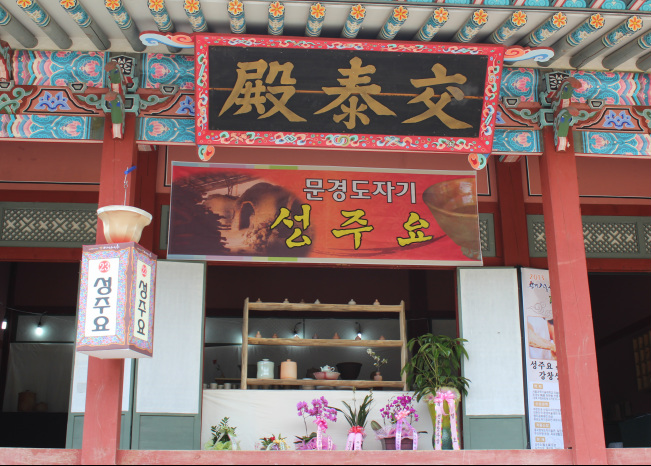










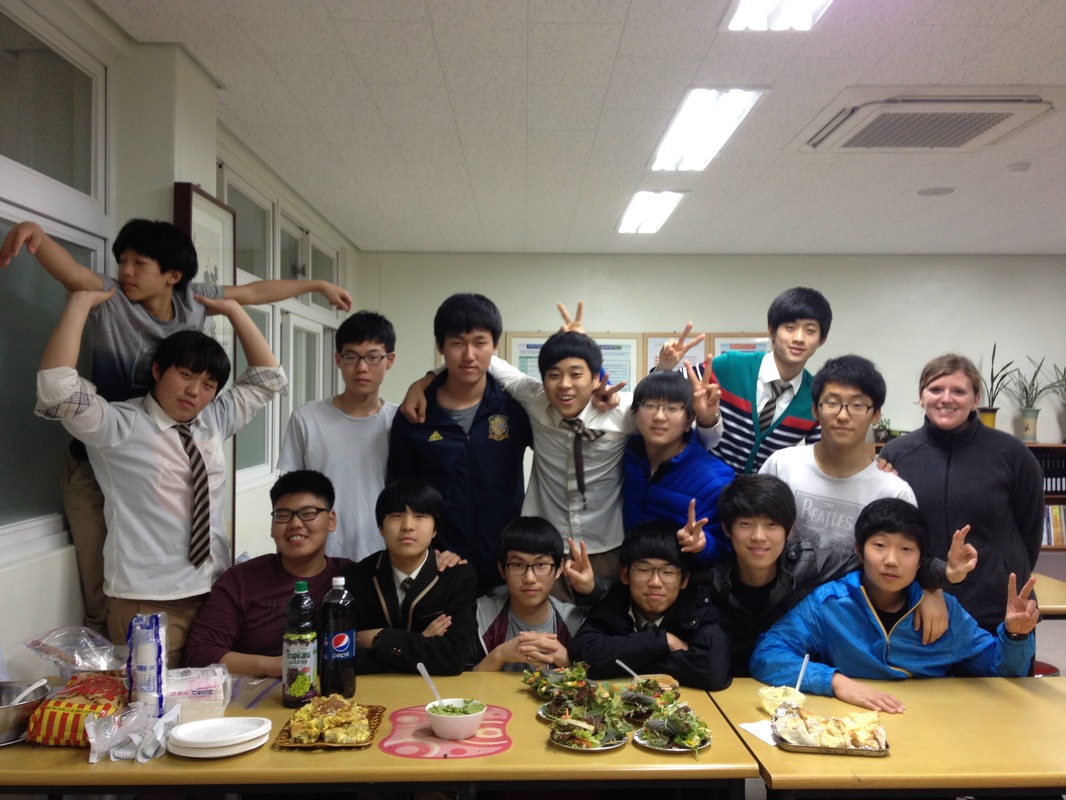










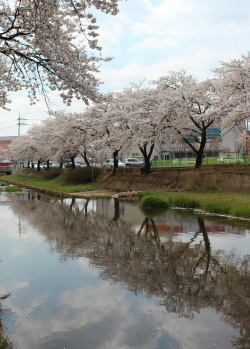


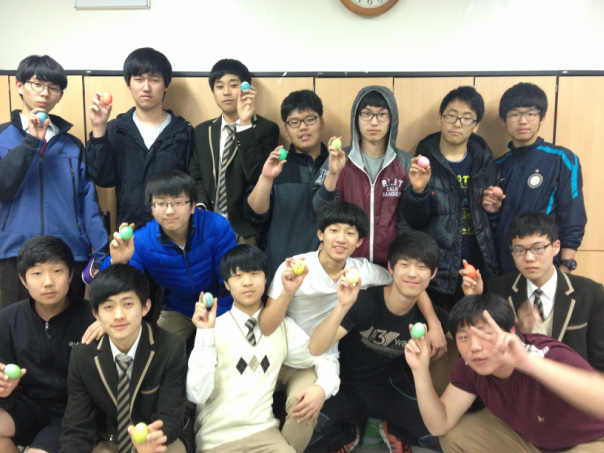
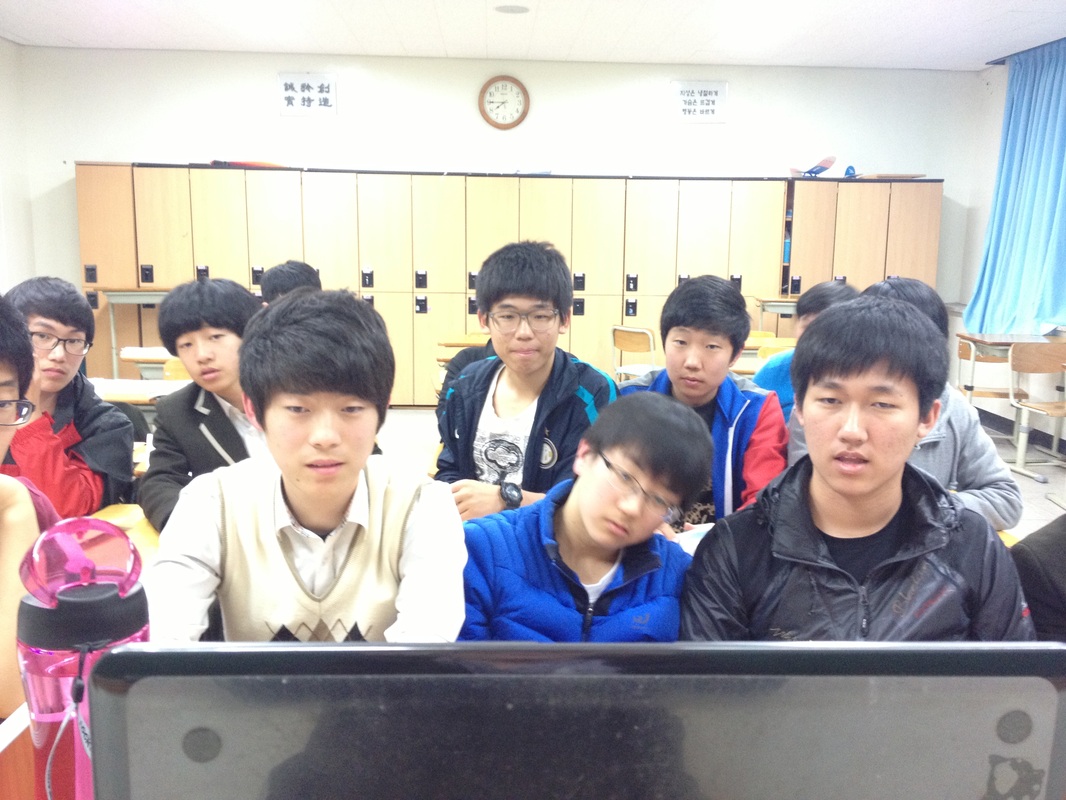
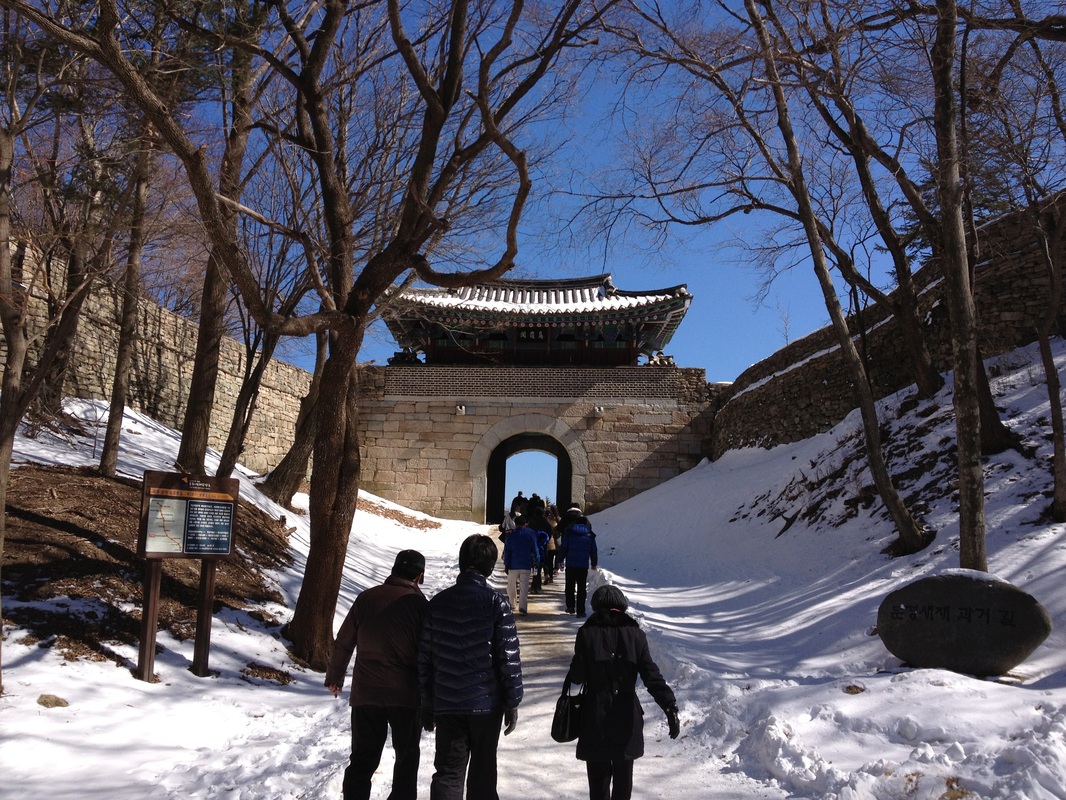
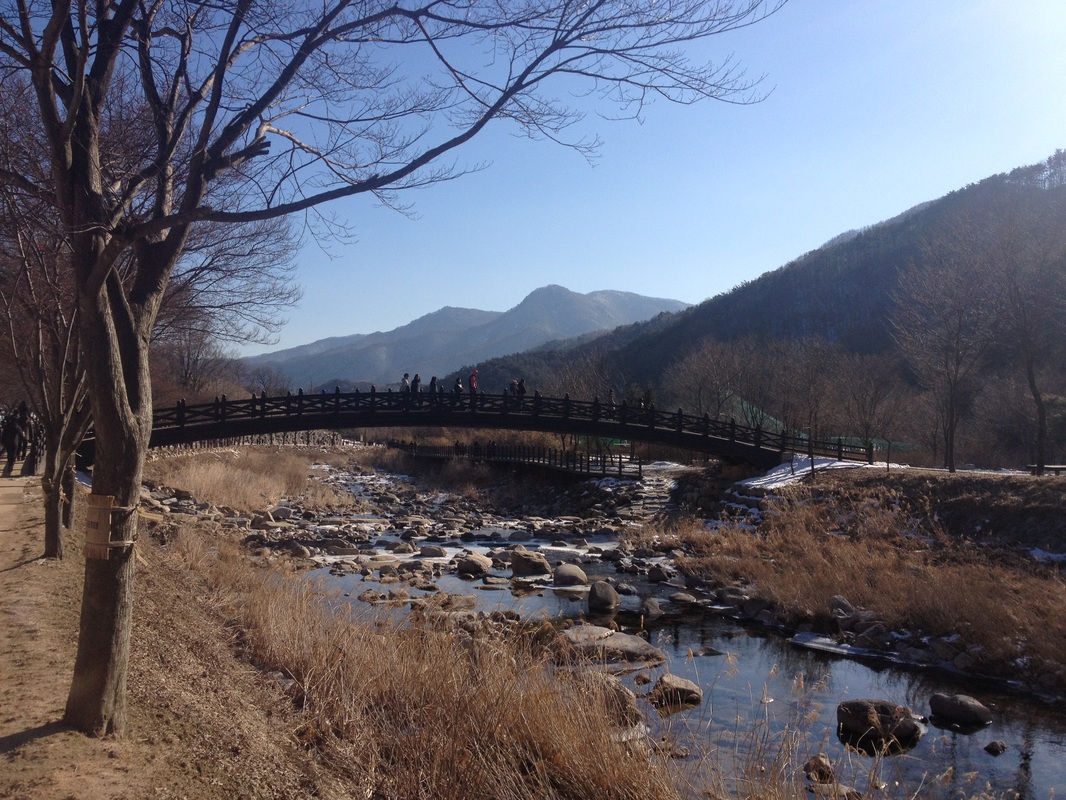
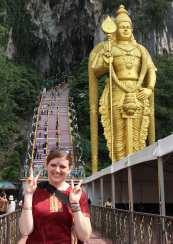
 RSS Feed
RSS Feed